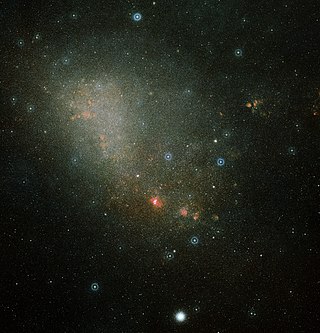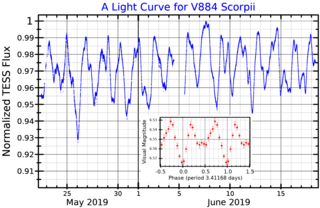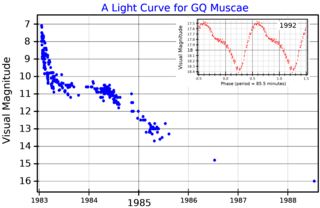
The Small Magellanic Cloud (SMC), or Nubecula Minor, is a dwarf galaxy near the Milky Way. Classified as a dwarf irregular galaxy, the SMC has a D25 isophotal diameter of about 5.78 kiloparsecs (18,900 light-years), and contains several hundred million stars. It has a total mass of approximately 7 billion solar masses. At a distance of about 200,000 light-years, the SMC is among the nearest intergalactic neighbors of the Milky Way and is one of the most distant objects visible to the naked eye.

Musca is a small constellation in the deep southern sky. It was one of 12 constellations created by Petrus Plancius from the observations of Pieter Dirkszoon Keyser and Frederick de Houtman, and it first appeared on a celestial globe 35 cm (14 in) in diameter published in 1597 in Amsterdam by Plancius and Jodocus Hondius. The first depiction of this constellation in a celestial atlas was in Johann Bayer's Uranometria of 1603. It was also known as Apis for 200 years. Musca remains below the horizon for most Northern Hemisphere observers.
A flare star is a variable star that can undergo unpredictable dramatic increases in brightness for a few minutes. It is believed that the flares on flare stars are analogous to solar flares in that they are due to the magnetic energy stored in the stars' atmospheres. The brightness increase is across the spectrum, from X-rays to radio waves. Flare activity among late-type stars was first reported by A. van Maanen in 1945, for WX UMa and YZ CMi. However, the best-known flare star is UV Ceti, first observed to flare in 1948. Today similar flare stars are classified as UV Ceti type variable stars in variable star catalogs such as the General Catalogue of Variable Stars.

71 Tauri is a suspected triple star system in the zodiac constellation Taurus, located 146 light years from the Sun. It is visible to the naked eye as a faint, yellow-white hued star with an apparent visual magnitude of +4.48. The star is moving further away from the Earth with a heliocentric radial velocity of +38 km/s. It is a member of the Hyades open cluster.

Alpha Muscae, Latinized from α Muscae, is a star in the southern circumpolar constellation of Musca. With an apparent visual magnitude of +2.7, it is the brightest star in the constellation. The distance to this star has been determined using parallax measurements, giving an estimate of about 315 light-years from Earth.

II Pegasi is a binary star system in the constellation of Pegasus with an apparent magnitude of 7.4 and a distance of 130 light-years. It is a very active RS Canum Venaticorum variable, a close binary system with active starspots.
AM Canum Venaticorum is a hydrogen-deficient cataclysmic variable binary star in the constellation of Canes Venatici. It is the type star of its class of variables, the AM Canum Venaticorum stars. The system consists of a white dwarf gaining matter via an accretion disk from a semi-degenerate or white dwarf companion.

4U 1700-37 is one of the stronger binary X-ray sources in the sky, and is classified as a high-mass X-ray binary. It was discovered by the Uhuru satellite. The "4U" designation refers to the fourth Uhuru catalog.
Hercules X-1, also known as 4U1656+35, is a moderately strong X-ray binary source first studied by the Uhuru satellite. It is composed of a neutron star accreting matter from a normal star probably due to Roche lobe overflow.

UX Arietis is a triple star system located in the northern zodiacal constellation of Aries. Based upon parallax measurements from the Gaia satellite, it is roughly 165 light years away. The primary, component Aa, is a variable star of the RS CVn type. The variability of the star is believed due to a combination of cool star spots and warm flares, set against the baseline quiescent temperature of the stellar atmosphere. The variability appears to be cyclical with a period of 8−9 years. The star varies in brightness from magnitude 6.35 to 6.71, meaning it may be intermittently visible to the unaided eye under ideal dark-sky conditions.

S Muscae is a classical (δ) Cepheid variable star in the constellation Musca about 2,600 light years away.

TU Muscae, also known as HD100213, is an eclipsing binary star in the constellation Musca. Its apparent magnitude ranges from 8.17 to 8.75 over around 1.4 days.

GQ Muscae, also known as Nova Muscae 1983 is a nova in the constellation Musca, which was discovered by William Liller at 03:20 UT on 18 January 1983. At the time of its discovery it was a magnitude ≈7.2 object, and it subsequently faded.
4U 1543-475 is a recurrent X-ray transient located in the southern constellation Lupus, the wolf. IL Lupi is its variable star designation. It has an apparent magnitude that fluctuates between 14.6 and 16.7, making it readily visible in large telescopes but not to the naked eye. The object is located relatively far at a distance of approximately 17,000 light years based on Gaia DR3 parallax measurements.

RS Canum Venaticorum is a binary star system in the northern constellation of Canes Venatici. It serves as the prototype to the class of RS Canum Venaticorum variables. The peak apparent visual magnitude of this system is below the level needed to observe it with the naked eye. It is located at a distance of approximately 443 light years from the Sun based on parallax, but is drifting closer with a net radial velocity of −14 km/s. Olin J. Eggen (1991) included this system as a member of the IC 2391 supercluster, but it was later excluded.

XY Ursae Majoris is a short period binary star system in the northern circumpolar constellation of Ursa Major. It is an eclipsing binary with a baseline apparent visual magnitude of 9.50. The system is located at a distance of 221.5 light years from the Sun based on parallax measurements, but is drifting closer with a radial velocity of −10 km/s. It has a relatively high proper motion, traversing the celestial sphere at the angular rate of 0.191″·yr−1.

SZ Piscium is a suspected triple star system in the equatorial constellation of Pisces. The inner pair form a double-lined spectroscopic binary with an orbital period of 3.966 days. It is a detached Algol-type eclipsing binary of the RS Canum Venaticorum class with a subgiant component. The system is too faint to be readily visible to the naked eye with a combined apparent visual magnitude of 7.18. It is located at a distance of approximately 306 light years based on parallax measurements.

DM Ursae Majoris is a binary star system in the northern circumpolar constellation of Ursa Major, abbreviated DM UMa. It is sometimes identified by the Bonner Durchmusterung catalogue designation BD +61 1211; DM UMa is the variable star designation. The system has a combined apparent visual magnitude of 9.29, which is too faint to be visible to the naked eye. Based on parallax measurements, the system is located at a distance of approximately 606 light years from the Sun, but it is drifting closer with a heliocentric radial velocity of −7 km/s.

HR 1099 is a triple star system in the equatorial constellation of Taurus, positioned 11′ to the north of the star 10 Tauri. This system has the variable star designation V711 Tauri, while HR 1099 is the star's identifier from the Bright Star Catalogue. It ranges in brightness from a combined apparent visual magnitude of 5.71 down to 5.94, which is bright enough to be dimly visible to the naked eye. The distance to this system is 96.6 light years based on parallax measurements, but it is drifting closer with a radial velocity of about −15 km/s.
AR Piscium is a binary star system in the northern constellation of Canes Venatici, abbreviated AR Psc. It has the Henry Draper Catalogue identifier HD 8357; AR Piscium is its variable star designation. The pair have a combined apparent visual magnitude that fluctuates around 7.24, which is too faint to be readily visible to the naked eye. Parallax measurements place it at a distance of 148 light years from the Sun. The motion of this star through the Milky Way suggests it is a member of the intermediate disc population.














